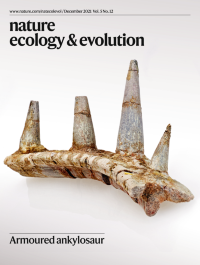Nature ecology & evolution
Volume 5 Issue 12, December 2021
Armoured ankylosaur
The holotype specimen of the armoured dinosaur Spicomellus afer. Spicomellus (pictured here) is the earliest ankylosaur so far described and the first from Africa. The specimen comprises spikes directly fused to the animal’s ribs, a morphology unique to this species.
See Maidment et al.
Image credit: Jonathan Jackson, The Natural History Museum. Cover Design: Allen Beattie.
Editorial
Editorial | 02 December 2021
Probing the plasmid paradox
This month we celebrate plasmids as drivers of microbial ecology and evolution, and highlight active areas of research.
Correspondence
Correspondence | 14 October 2021
Improving pesticide-use data for the EU
- Robin Mesnage
- Edward A. Straw
- Elena Zioga
Comment & Opinion
Obituary | 18 October 2021
Angela Milner (1947–2021)
Far-sighted palaeontologist who guided the Dinosaur Gallery at London’s Natural History Museum, with interests in dinosaurs, early tetrapods and palaeoneurology.
- Stig Walsh
Books & Arts
Books & Arts | 08 November 2021
Reforming social genetics
- Aylwyn Scally
Research Highlights
Research Highlight | 01 November 2021
Treasure-hunting bees
- Vera Domingues
Research Highlight | 01 November 2021
Native Mexican adaptation
- Vera Domingues
Research Highlight | 01 November 2021
Farming adaptations
- Alexa McKay
Research Highlight | 01 November 2021
Beyond English language
- Vera Domingues
Research Highlight | 08 November 2021
Invasive hogs
- Walter Andriuzzi
Research Highlight | 08 November 2021
Predation drives diversity
- Marian Turner
Research Highlight | 08 November 2021
Viral priorities from genomic signatures
- Marian Turner
Research Highlight | 15 November 2021
Symbiotic seagrasses
- Marian Turner
News & Views
News & Views | 04 November 2021
Functional forest restoration
The strength of functional diversity effects on forest productivity increases over time, highlighting the key role of multi-species tree communities in long-term restoration initiatives.
- Nathaly R. Guerrero-Ramírez
News & Views | 03 December 2021
A flurry of sex-ratio distorters
Two analyses of long-read sequencing show that the Winters sex-ratio distorter of Drosophila has been a part of a recent gene family expansion, coupled to the appearance of suppressors, in a genomic arms race driven by satellite DNA.
- Aaron A. Vogan
Research
Article | 23 September 2021
Bizarre dermal armour suggests the first African ankylosaur
The authors report a fossilized vertebrate rib with spiked dermal armour fused to its dorsal surface from the mid-Jurassic of Morocco, which they interpret as the earliest known ankylosaur.
- Susannah C. R. Maidment
- Sarah J. Strachan
- Paul M. Barrett
Article | 20 September 2021
Species richness is more important for ecosystem functioning than species turnover along an elevational gradient
The authors measure numerous ecosystem functions across an elevational gradient on Mt Kilimanjaro and find that species richness impacts function more than species turnover across sites. They also show that variation in species richness impacts ecosystem functioning more strongly at the landscape scale than at the local scale.
- Jörg Albrecht
- Marcell K. Peters
- Matthias Schleuning
Article | 04 November 2021
Functional diversity effects on productivity increase with age in a forest biodiversity experiment
In a long-running forest biodiversity experiment in China, the authors ask which measures of tree functional trait diversity impact productivity as forests develop. While productivity increased with community-weighted mean trait values early on, after 7 years productivity was significantly increased in plots with higher functional diversity.
- Franca J. Bongers
- Bernhard Schmid
- Xiaojuan Liu
Article | 06 September 2021
Satellite DNA-mediated diversification of a sex-ratio meiotic drive gene family in Drosophila
Some Drosophila species have cryptic sex-ratio drive systems. Here, the authors show rapid expansion of a driver gene family, Distorter on the X, in three closely related Drosophila species on the X chromosome and suppressors on the autosomes.
- Christina A. Muirhead
- Daven C. Presgraves
Article | 03 December 2021
Rapid evolutionary dynamics of an expanding family of meiotic drive factors and their hpRNA suppressors
The Dox meiotic drive system distorts the sex ratio in Drosophila simulans. Here, the authors reconstruct the stepwise emergence, and recent amplification of Dox superfamily genes in parallel with the emergence of autosomal hairpin RNA-class siRNA loci that target subsets of these putative drivers.
- Jeffrey Vedanayagam
- Ching-Jung Lin
- Eric C. Lai
Article | 08 November 2021
Plasmids do not consistently stabilize cooperation across bacteria but may promote broad pathogen host-range
Horizontal gene transfer could stabilize cooperation in bacteria because plasmids could promote the transfer of genes encoding public goods. However, the authors use comparative analysis and theoretical modelling to show that, while horizontal gene transfer may help cooperative genes invade a population initially, they have less of a role in long-term maintenance of cooperation.
- Anna E. Dewar
- Joshua L. Thomas
- Melanie Ghoul
Amendments & Corrections
Author Correction | 28 September 2021
Author Correction: The genome of Nautilus pompilius illuminates eye evolution and biomineralization
- Yang Zhang
- Fan Mao
- Ziniu Yu
Author Correction | 13 October 2021
Author Correction: Meeting frameworks must be even more inclusive
- Gabriela Serrato Marks
- Caroline Solomon
- Kaitlin Stack Whitney
Author Correction | 25 October 2021
Author Correction: Priority list of biodiversity metrics to observe from space
- Andrew K. Skidmore
- Nicholas C. Coops
- Vladimir Wingate



No Comment